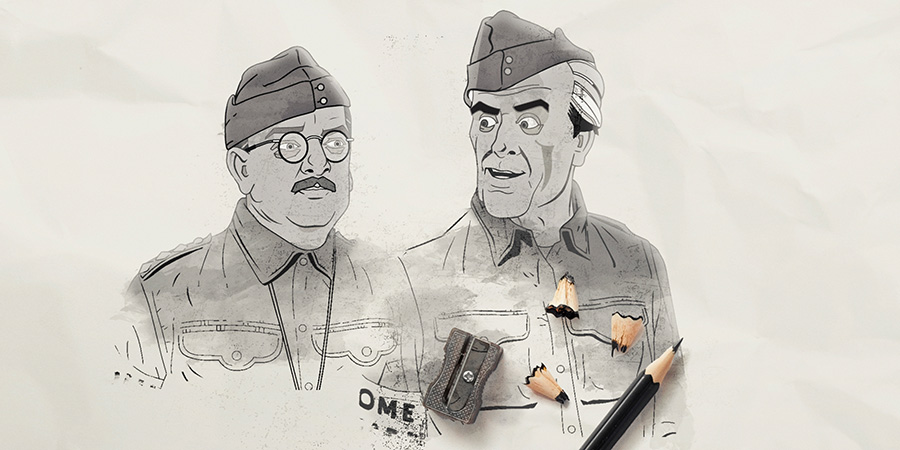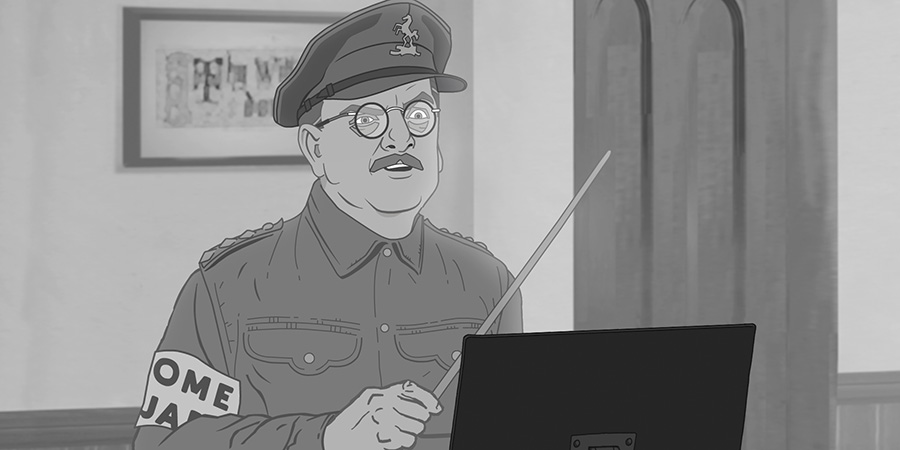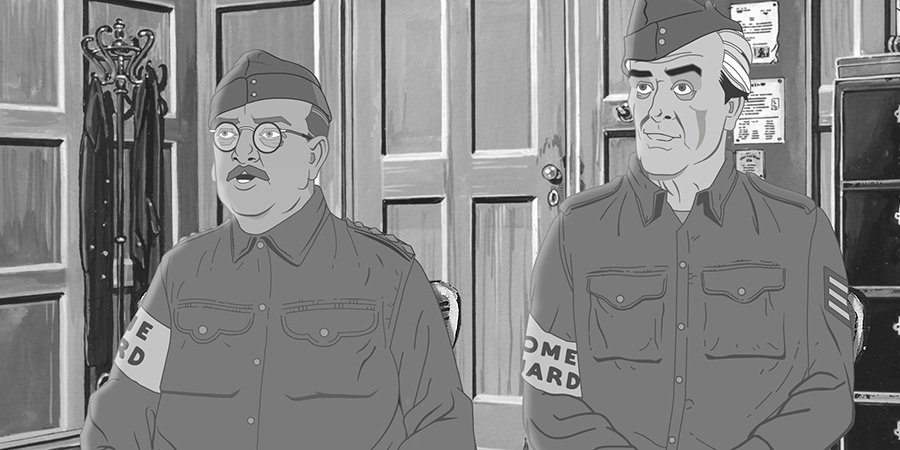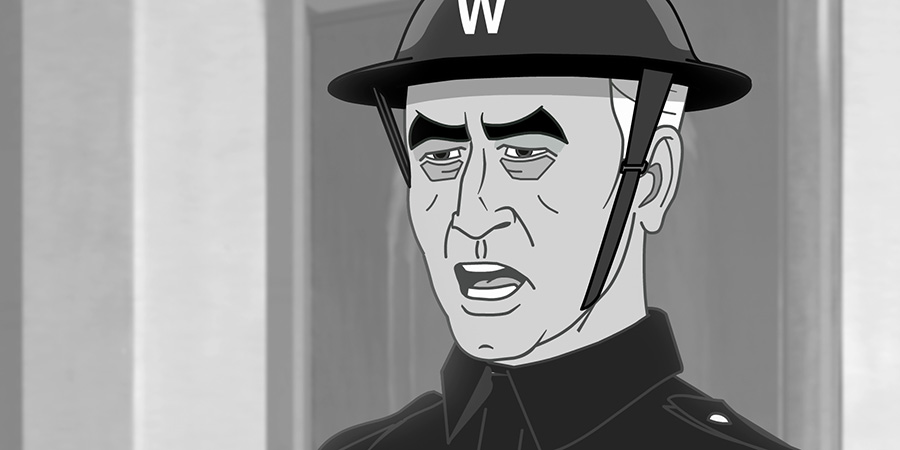Interview with director Charles Norton

As Dad's Army: The Animations brings five lost episodes of the iconic sitcom back to life from audio recordings, director Charles Norton talks exclusively to British Comedy Guide about the daunting task of bringing a television institution into a new, animated form.
What are the key differences between directing animated and live action comedy?
Well, it's a completely different medium. The strengths and weaknesses are entirely different. There are so many things that are very easy to do in live action that are very hard to do in animation. And likewise, there's lots of things that are relatively straightforward to do in animation, that would be almost impossible on most live action shoots. And the schedule comes into play too. These animations are often turned around on a very tight production schedule and you have to manage your resources carefully. With animation, there are fewer ways to cheat your way around a tight schedule or limited resources.
I suppose that the obvious one is just basic action stuff. If the script has a character walk across a room and pick up a box of matches from the floor, then that's one of the easiest things in the world to shoot live action. Much of the main action would be covered in a wide-shot, probably favouring a profile of the character, to make it clearer to see what they're doing. We might cut in a shot of them picking up the box, but we would probably have the camera fairly far back most of the time, to better capture the movement.
However, that same scene on an animated production isn't straightforward at all. What you could shoot in a few minutes in live action, will take weeks to complete in animation. As soon as you have a character performing a complex movement like that, things get very time-consuming very quickly. Anything that breaks out of the basic stock pose of the character and you suddenly find yourself with a lot of work to do, a lot of drawing and redrawing, trying to get all those poses to look right and natural, trying to get the movements to flow naturally. You can't just cheat it by bobbing a character around in frame. They actually need to walk and move like a human being. And they're not a human being. They're a drawing. Or rather, they're lots of drawings.

In fact, with quite tightly limited resources, such a scene is likely to be so time-consuming that I will probably look into blocking my way around it, to avoid some of the hardest elements. On live action, I'd probably go wide on the shot. However, in animation, I'll be more tempted to break it up into component shots, cut away from the action to another character's reaction-shot and maybe crop in closer on the walking character during the action. Anything really to reduce the number of poses we need to draw. We're actually sort of helped by the sitcom format here, where frequently a lot of the humour lies in people's reactions to what is going on, rather than the action itself.
David Croft would often show you a character reacting to something physical, rather than show you the physical thing itself. It moves the focus of the show away from slapstick comedy toward more character-based comedy. That's basically the David Croft format actually. It's often funnier. And, of course, a bit cheaper.
In short, you probably find yourself focusing on character's faces a lot more in animation (or at least, you do when you've got to stay within a certain budget). You spend a lot of time building a great deal of character into the variety of expressions - known as facial kits - for this very reason. They really need to be able to act and feel like the characters they're supposed to be. You can't be vague or broad-brush about the detail (as you normally would on a lot of animated shows). When you're up close in Arthur Lowe's face, you need the drawn character to feel like Arthur Lowe, to act like him and emote like him. You have to be able buy that it's the same character underneath the artwork. A cartoon yes, but a cartoon of that person.

This is probably the area where we diverge most from the way such similar limited animation projects are usually tackled. Normally, things like the mouth shapes for each character are pretty generic in this form of animation. Same with the eyes too. It's normally about just trying to convey the lip-sync in clear and easy to follow forms and shapes - something simple and distinct. In fact, it's quite common for a basic generic set of mouth shapes to be shared between a number of characters. But we don't do it like that.
It's an awful lot of work, but we (or rather our character artist, Martin Geraghty) spends an enormous amount of time getting each mouth-shape, tick, grimace and expression, just right. It has to fit the character. Even if it's only on screen for a fraction of a second, it all combines to form a more complete impression of that character. There are no short-cuts here. Or rather, there are, but you shouldn't take them. You're always looking for ways to communicate the character - who they are and what they're thinking. Most of that is in the face.
So, Martin will sit down with a video of a Dad's Army episode and he will spin through looking for a good series of shots of a particular character. He will then freeze-frame bits of the action, as the character is talking, to get reference for the way that character forms each syllable as they talk. We tend to break human speech down into a stock of basic mouth-shapes in animation (sometimes called phonemes). These are essentially, the shapes your mouth makes as it forms certain sounds when you speak. So, the 'A' shape and the 'ee' shape and things like that. Some double up. So, when you make a 'F' sound, what you do with your lips is very close to what your lips do when you make a 'V' sound. 'M', 'B' and 'P' are also very similar. You can usually distil human lip-sync down to between nine and a dozen basic shapes.

Thing is though, each person forms their shapes just that little bit differently. So, Arthur Lowe doesn't move his lips very much at all. He sort of pushes the words out from under his moustache. Frazer on the other hand has a very large and quite elastic mouth. When he shouts, it's almost like his jaw dislocates. So, Martin will go through each character and create a bespoke set of mouth shapes for each character in turn, so that they all feel distinct and in character. And he'll do that for every angle of the head that is used in the animation. So, there'll be about a dozen mouths for the forward-facing head; about a dozen for the three-quarter facing head and a dozen each for both the profile head and the over-the-shoulder angle. For each and every character. And that's before you even get started on the other shot-specific expressions - the frowns and smiles and looks of shock and pain. There'll be a fair few of them per-character too. All in all, it's a lot of drawing. However, if you build all that into the kits from the start, then it gives you a lot of flexibility and emotional range, which is vital for such a strongly character-based comedy like Dad's Army.
How did the inclusion of studio audience laughter affect your creative decisions?
We didn't actually have the final camera scripts to work from on this. Or at least, we didn't get copies of them until we were nearly finished production. We were mostly working with the rehearsal scripts. Consequently, there were times where you're listening to the audio and you hear a huge laugh from the audience, but you don't really know quite what it is they're laughing at. You know that something physical has happened that wasn't scripted (or at least isn't in the rehearsal scripts) and you can gauge from the audience that is was probably very funny, but you sort of have to just guess what it might actually have been. Or failing that, just make something up that feels right.
One example is in The Cornish Floral Dance where there's a huge gap where the audience are absolutely falling about in hysterics for almost a minute. There's no sign in the script of what happened there though. My guess is that it's Arthur Lowe's reaction to the platoon singing. In fact, it pretty much must be. There's nothing else they could have cut to. So, we spent a bit of extra time on that shot, boarding it out, to try and work out some facial reactions that would work in context.
Myself and Adrian Salmon (our storyboard artist) talked about how much we could try to get across with his face alone. Easy when you've got Arthur Lowe in the studio, of course. You can pretty much just point a camera at him and he will give you something that will work on the day. In animation, the whole thing needs to be built from the ground up. I think Adrian and I talked about a number of famous wordless scenes from films, where the actor's just there in the medium close up, telling you everything that's in his head without speaking. Rather an odd combination, but both The Long Good Friday and Trains, Planes And Automobiles were cited. In the former's case for the last scene and in the latter's case for the first scene. The final animation for that shot (a single, long, medium-close-up of Mainwaring on his own) was done by Deanna Werthauer over in Boston. We spent a lot of time on it, for such a short section.

Other audience cues are easier to figure out. So, there's a bit where Jones bites Warden Hodges in The Cornish Floral Dance and quite a lot of stuff in Poles Apart where the platoon are lying on the floor. It's fairly clear what is probably going on from the context. Although in the latter's case, we didn't even have a rehearsal script to work from.
Plus of course, you insert things that were probably never there in the first place, but just feel right in the context of the scene. So, Mainwaring and Wilson exchange Christmas presents in Poles Apart, which just felt quite touching and a reminder that these two men were still meant to be friends after all. There was also a comic book added to a scene in the War Office in The Loneliness Of The Long-Distance Walker, which pricked the pomposity of what otherwise ran the risk of being a fairly generic supporting character and made them a bit more of a human being that we could immediately latch onto and recognise as a person, rather than just a device to cover some necessary plot points.
What are the differences between the finished animations and the original TV and radio episodes?
The radio broadcasts are shorter than the TV episodes to begin with (about three or four minutes shorter). That's before we do any editing at all. Each radio episode also had an introductory monologue at the front of it, that was unique to the radio episodes and had nothing to do with the TV episode. These were written by Michael Knowles and Harold Snoad (who adapted the scripts, and not David Croft and Jimmy Perry). Once you've removed that monologue and re-edited the remaining material to more closely follow the script of the original TV episode (using those 1969 rehearsal scripts as a guide), what you're left with is inevitably going to be a little shorter than the original TV episode. In some cases, we are able to reinstate material from the original TV script (that was removed for the radio adaptation). In other cases, we are not. It depends on the scene.
Loneliness Of The Long-Distance Walker is certainly the shortest of the two episodes that we used radio material on. This is due, in no small part, to the decision taken by the production team of the radio episode back in 1973 to cut a scene in the middle of the episode that was set in an air raid shelter. We did actually re-record this scene back in March this year, using David Benson as the voice of Wilson and Jack Lane as the voice of Mainwaring. However, cutting from Arthur Lowe in one scene to Jack Lane in the next scene - and then back again - really just jarred too much. So, we left that scene out (just as they did in late 1973 when the radio episode was recorded). You can however listen to our re-recorded approximation of that scene on the DVD, where it's presented as a deleted scene.

Other sections of Loneliness Of The Long-Distance Walker were easier to reinstate. So, everything at the army camp was re-recorded from scratch using the original 1969 scripts. This enabled us to include more of the original script than the 1973 radio recording had used. And we were able to integrate it quite well, as the section didn't include any regular characters other than Walker.
The other radio-sourced episode, Under Fire, is much longer in animated form - only about 90 seconds shorter than the radio version (if I recall correctly). And of course, all the other animated episodes use the original TV audio anyway and so aren't missing anything to begin with.
In the end, we did the best we could to get Loneliness Of The Long-Distance Walker and Under Fire as close as possible to the original TV scripts. However, with all of the lead actors dead, there are limits to what is practical. We can reinstate the original music and re-record some sections that don't survive in the radio edit. However, if the radio episode missed out a large chunk when they recorded the adaptation, it's hard to recreate that from nothing.
Broadly speaking, if it's in both the 1973 radio version and the original 1969 TV episode, then it's in the animation. If it's only in the 1969 TV episode, but not in the 1973 radio recording, then we can sometimes bring it back into existence, but not always. Likewise, if it's new to the 1973 radio version and was never originally part of the 1969 TV episode, then it sometimes won't be in the animation (but sometimes will).
Help us publish more great content by becoming a BCG Supporter. You'll be backing our mission to champion, celebrate and promote British comedy in all its forms: past, present and future.
We understand times are tough, but if you believe in the power of laughter we'd be honoured to have you join us. Advertising doesn't cover our costs, so every single donation matters and is put to good use. Thank you.
Love comedy? Find out moreDad's Army - The Missing Episodes

Between 1968 and 1977, the BBC broadcast 84 television episodes of Dad's Army. Across nine series and seven Christmas specials, the programme continues to be one of the most beloved of all British sitcoms. However, not every episode of Dad's Army still survives in its original format. Five episodes were never formally archived by the BBC and are today presumed lost. No footage is known to exist from any of these episodes. They are collectively some of the most sought-after of all lost television programmes.
Happily, audio-only recordings have survived of all five of these lost classics. These audio recordings (starring Arthur Lowe, John Le Mesurier and Clive Dunn) have been painstakingly reassembled and restored and are now used as the basis for a series of new animated episodes of Dad's Army - featuring all new hand-drawn black and white animation, synced up to the words of the original actors.
These new animated episodes give audiences a chance to enjoy five original episodes of this much-loved comedy classic for the first time in over fifty-years.
First released: Monday 27th November 2023
- Distributor: BBC
- Region: 2
- Discs: 1
- Minutes: 102
- Subtitles: English
- Catalogue: BBCDVD4562
![]() Buy and sell old and new items
Buy and sell old and new items
Search for this product on eBay
BCG may earn commission on sales generated through the links above.

